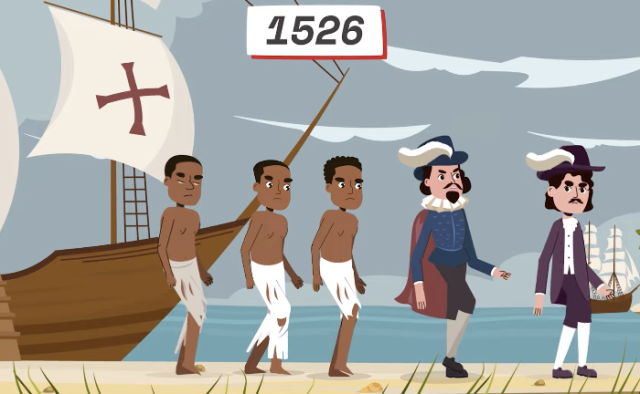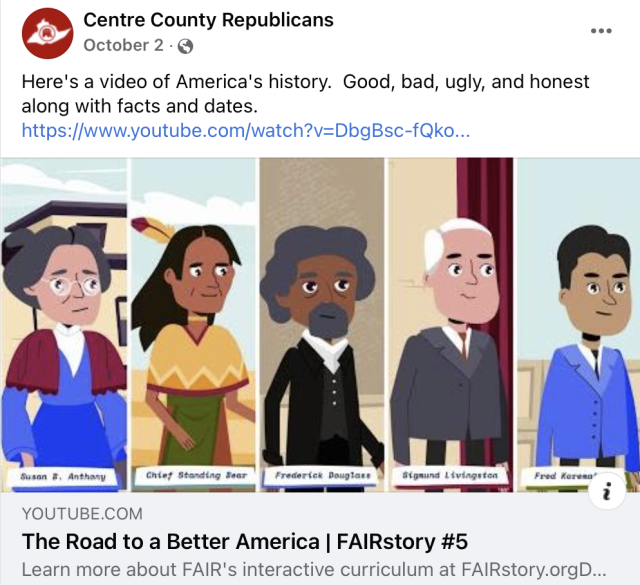
Views from the Commons
Posts Filtered by Type - FAIRStory |
Show Recent Posts
March 12, 2022
FAIRstory 3: The Jefferson Paradox
by Hal Wright
FAIRstory 3: The Jefferson Paradox
by Hal Wright
To take the next steps toward universal equity, our country must reckon with the full historical record of its most hypocritical Founder. We will struggle to do so, and FAIRstory's whitewash of Jefferson's legacy will not help.
Recently, I wrote about a treatment of Thomas Jefferson on 1980s network television: how Sally Hemings had been impregnated by Jefferson seven times, and how White Americans reconciled that fact with their admiration of Jefferson as a Founder.
Where Jefferson is concerned, little has changed since the 1980s. The backlash sidestepped by network TV then has reached full intensity, directed at initiatives to meet head-on the impact of Jefferson and other enslavers on enslaved persons and their descendants.
In response to the removal of Confederate statues and place names, Donald Trump and his acolytes warned that progressives would be coming for Thomas Jefferson next. To activate fear, they have propagated the false claim that, in revealing Jefferson's legacy as an enslaver, progressives intend to destroy the country. Of course, the fissures being exploited by right-wing politicians weren't put there by progressives. They exist because Jefferson embedded in our country the same internal contradictions we find in Jefferson's own mind.
Thus, it's no surprise that FAIRstory treats Jefferson gently and with more than a little spin.
After a fleeting acknowledgement that he owned slaves, FAIRstory praises Jefferson for condemning slavery in the original draft of the Declaration of Independence. In fact, he condemned the slave trade, targeting the Crown for their role in creating the slave trade and for granting freedom to the enslaved as a means of destabilizing the simmering rebellion of the Colonies. Jefferson could have freed his slaves on any day of his adult life. He freed only two in his lifetime and five in his will.
In FAIRstory’s Video #8, Jefferson’s signing of the bill to end the transatlantic importation of slaves receives mention without the context that the market value of the people Jefferson and others enslaved increased as a result.
Any public reckoning of our history must include an unabridged account of Jefferson’s words and deeds: the good, the bad, and the ugly. FAIRStory panders to the right by skirting this essential responsibility.
This article has been edited to omit information provided in a previous post.

December 30, 2021
FAIRstory 2: Mistakes Were Made
by Hal Wright
FAIRstory 2: Mistakes Were Made
by Hal Wright
Are stories about atrocities committed during the European conquest of North America more palatable to white, right-leaning Americans when the atrocities are described in the passive voice? FAIRstory's authors seem to think so.
FAIRstory has emerged as an alternative to current diversity, equity and inclusion (DEI) initiatives, with the goal of “advancing civil rights and liberties for all Americans." Its founder, musician Daryl Davis, has grown famous for persuading members of right-wing hate groups to examine and ultimately to discard their hateful beliefs. That's impressive and necessary work. The question we must ask though is whether a social studies curriculum founded on persuasion rather than on telling of the whole truth serves the educational goals of a public school.

A screenshot from FAIRStory Video #7
FAIRstory's default use of the passive voice to describe atrocities in US history creates issues of improper framing. People of color “were previously denied rights.” Native Americans “were not even considered people.” Japanese Americans “were forced into internment camps.” Things in the South "got much worse." And so on.
To illustrate the problem, let's rewrite just a little of this narrative in the active voice.
"Eager to gain control of and to make profitable new territories rich in natural resources, many colonists embraced a brand of racism in which people of color were unworthy of the human rights the colonists established for themselves. Over time, colonists and their enablers kidnapped and enslaved millions of Africans, while leaders in the nascent US government created legal pathways to permit chattel slavery and to expand farmland available to enslavers through the slaughter and forced relocation of native populations."
In naming the depravity without describing the mechanisms by which the perpetrators got away with it, FAIRstory obscures the extent which enslavers embedded racism into the political and economic systems of the United States. That remnants of systemic racism survive in our institutions to the present day is an inconvenient truth the authors of FAIRstory prefer to downplay.
In video #5, we encounter what is perhaps FAIRstory's most problematic framing: its statement that the US "was born with slavery and abolitionism." The "-ism" in "abolitionism" is verbal sleight of hand worthy of a Philadelphia lawyer. The United States was born with slavery, full stop. Some folks objected and wrote about it, and over time some states took actions to ban or to limit slavery within their borders. In the run-up to the Civil War, compromises were made to ensure that slavery would thrive in the South. FAIRstory presses the narrative that states' rights have proven helpful in our journey toward freedom for all. An equally valid narrative barely acknowledged by FAIRstory is that rich and powerful southerners who identified as white exploited states' rights to preserve and to intensify brutality against enslaved people for generations, and to extinguish the lives and liberty of freed African-Americans thereafter.
Further on in video #5, the passive voice gives way to micro-biographies of abolitionists and civil rights leaders throughout our history written in the active voice. FAIRstory describes fantasy scenarios in which a few persuasive individuals, emboldened by an irrepressible sense of fairness, singlehandedly bent the arc of history. In reality, of course, our journey away from slavery and discrimination has been uneven, messy, driven by a variety of social and emotional forces, and accompanied by episodes of mass activism which descended into violence. Words have always been just one step (and too often the only step) taken by the eloquent among us.
And about the words of those historical figures FAIRstory highlights in video #5? They were cherry-picked to create the false notion that the seeds of abolition have grown throughout time from no other fertilizer but an enlightened sense of the oneness of the human race. Nowhere to be found, for example, is Lincoln's ambivalence on race: his low opinion of the intelligence of enslaved Black Americans and his desire to see all of them depart the continent. Nor do we find King's admonitions about the trajectory of capitalism in America which became one focus of his activism shortly before his death.
History is the whole story of who did what with whom, for whom, to whom — and why they did it. in contrast, FAIRstory is a purpose-built attempt to heal our fractured nation by amplifying selected parts of its history while disguising others. It's interesting material and I do not regret the time I spent with it. But it's not a worthy history lesson, any more than the white-washed public school curricula of the past. Learning to live with hard truths without taking your bad feelings out on the messenger or on the victims is a necessary skill too few of us have been compelled to master.
This article has been edited for clarity.

December 11, 2021
FAIRstory 1: Worms Eating at the Rind
by Hal Wright
FAIRstory 1: Worms Eating at the Rind
by Hal Wright
FAIRstory has emerged as one alternative to current diversity, equity and inclusion programs. It's purpose-built to appeal to the "anti-CRT" crowd, and does not belong in any public school.
I first became aware of FAIRstory in a post to the Centre County Republicans Facebook page. In the aftermath of last year's election, the Centre County Republican Committee promoted the Big Lie. After January 6th, they tried to inoculate themselves from blame by denouncing the violence. Trying to have it both ways is how they roll in a county with a blue middle surrounded by deep red.
So it's no surprise that they've embraced the FAIRstory approach. FAIRstory would like us to agree with the CCRC that they deal honestly with the good, the bad and the ugly of America's racist past. Let's take a closer look, though, to see what worms are eating at the rind. Fortunately, FAIRstory provides us with a roadmap to do so.

To sell a curriculum about slavery to right-leaning Americans in 2021, it's not good enough to simply deliver the materials. You have to try to own the libs. FAIRstory builds its "anti-CRT" cred in a critique of the Standards for Justice, a bellwether curriculum written by the Southern Poverty Law Center’s Learning for Justice project.
As academics, the authors of FAIRstory cannot impugn CRT like Republican politicians do, using the phrase as an umbrella for everything they don't like. Instead, they make the unsubstantiated claim that CRT "in recent months" has morphed into a "rejection of all systems implicated, however tangentially, with racist practices." The problem, you see, is not cynical right-wing politicians turning CRT into in a meaningless, inflammatory buzzword. The problem is liberals tearing down our institutions and culture. Right.
From this ideological perch, FAIRstory parses an "About" document authored by Teaching Tolerance (the precursor to Learning for Justice) word-for-word in search of things right wing politicians want them to find. Some of FAIRstory's bizarre claims:
- SPLC's use of the phrase "raising consciousness" has Marxist implications.
- SPLC's use of the word "democracy" without the modifier "American" in front reveals an anti-American bias.
- SPLC's use of the word "equitable" might link to radical CRT because “‘equitable’ can mean equality of outcomes."
In general, FAIRstory concern-trolls any mention of a person’s group identity and lived experience. Of course, systemic racism is oppression based on groups, groups often defined by the oppressor for their own benefit and with members who would rather not belong. An antiracist movement which isn't group-centric – which does not address how group identities intersect to influence a person's experience of their government and culture – is effectively defanged.
Right-wing politicians will recognize FAIRstory's tactics because they use them all the time. Political movements to expand human rights in the United States have always been collective in nature. To push back: Sever a person's connection to others similarly affected by bigotry, discrimination and hate with appeals to individuality. Delegitimize groups combatting racism by calling them Marxist, anti-American, and violent.
Of course, it goes without saying that the right has no intention of abandoning its collectives, and no intention of admitting into them any person who isn’t in lock step with their vision for our country.
The shame is, FAIRstory could have created a program emphasizing individual character to stand helpfully alongside such programs as Learning for Justice and The 1619 Project. But in its current form and with its implicit agenda, FAIRstory doesn’t belong in any US public school.
Future articles in this series will examine the FAIRstory approach in greater detail.
This article has been edited for clarity.

POSTS BY TYPE
POSTS BY TAG
POSTS BY MONTH